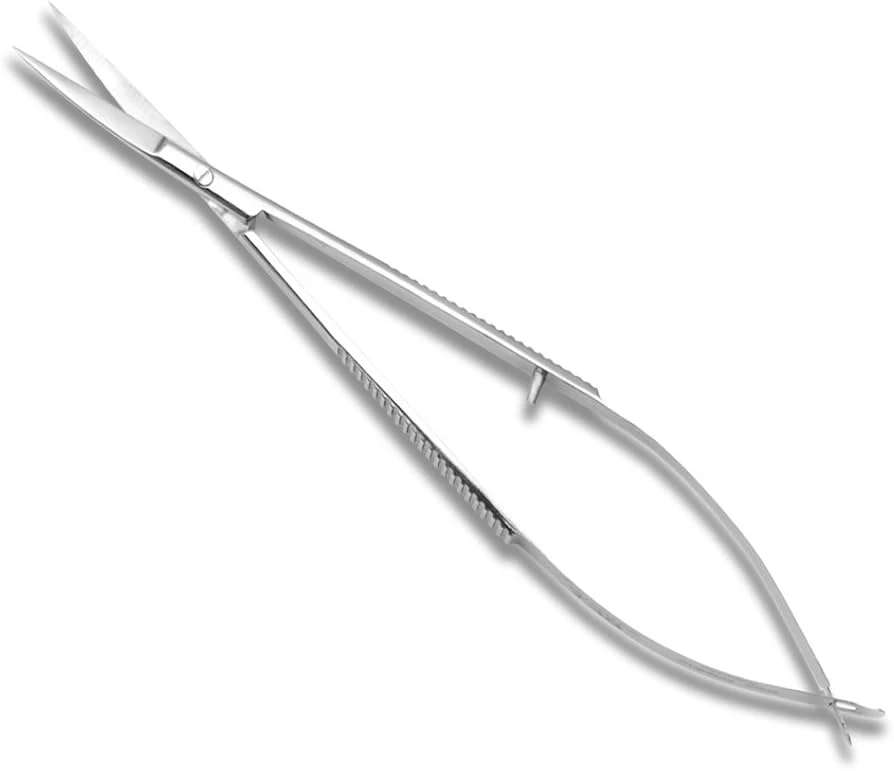
Here is a list of the top 15 machine embroidery tools to help you complete your projects more smoothly, enjoyably, and professionally.

These scissors have a paddle-shaped blade on one side, helping you to cut fabric close to the stitching without damaging the stitches themselves. They're essential for applique hobbyists because they are indispensable, giving you clean, precise edges every time.

Any embroiderer should have a pair of high-quality craft scissors. They are smaller than standard scissors, which allows for more control and accuracy while cutting threads or small areas of cloth. Keep these close to your embroidery machine for quick cutting.

EZ stitch snips are helpful spring-loaded scissors that make thread clipping so simple. These snips allow you to make quick, repeated cuts without straining your hand. If you need to cut threads between color changes, this tool will save you time.
Tweezers might look small, but angled precision tweezers may assist remove undesirable threads or handle small decorations that are difficult to manage by hand. They provide exceptional control and are a valuable tool for fine-tuning your work.
A stiletto and pressing tool is a dual-purpose tool that helps you guide fabric as it moves under the needle, preventing bunching and providing perfect stitches. The pressing end also helps to flatten seams and folds. This tool is helpful to anyone who works with layers.
A point turner is a small tool used for shaping and pressing points or edges. After stitching or embroidering something, use the point turner to carefully push out corners, giving a clean, professional look to your completed design.
The EZ point and turner are similar to the point turner but significantly more adaptable, especially for the soft fabrics. It is intended to gently turn the fabric right side out while minimizing stress on the edges, making it great for simple and complex designs.

Image Source
Paper tape works well for temporarily securing fabric or stabilizer layers without leaving residue or damaging the material. This is very useful for securing layers until you're ready to stitch them down.
Embroidery needles are accessible in different sizes and types, and choosing the right one makes a significant difference in your work.
For example, titanium-coated needles are more durable and keep sharper for longer. Having a range of quality needles on hand is important for different fabric types. And thread thicknesses.
Fabric glue gives a temporary hold, helping you to position patches or appliques precisely before stitching. It’s easy to use and helps avoid any shifting, making sure your stitching lands exactly where you want it.

Similar to fabric glue, spray adhesive has a quick, even layer of adhesive for temporary hold. It’s good for larger appliques or layers that need to stay perfectly still. Many embroiderers find it particularly helpful when working with silky or stretchy fabrics.
Sew Titles are magnetic fasteners that hold layers of fabric and stabilizers in place without leaving holes or residue. They are a lifesaver when dealing with delicate fabrics or intricate multi-layer designs, allowing you to secure everything without pins.
Do you know how to embroider with a sewing machine? Click here.
A thread stand helps feed thread smoothly from larger spools, reducing tension and preventing tangles or breaks. This is particularly useful for embroiderers who work with thicker threads or specialty threads that don’t fit in the machine’s standard holder.
Perfect placement kits come with guides and templates that help you align your embroidery designs accurately. This is a must-have for those working on items where symmetry and positioning are important, like logos or name patches.
Do you know how to make a black logo stand out in all colors? Click here.
An embroidery hoop mat provides a non-slip surface that helps stabilize the hoop and fabric while you work. It also reduces the risk of your fabric moving during embroidery, making it a valuable tool for anyone aiming for consistency in their work.
Embroidery is an art that requires not just skill but also the right tools. The 15 tools listed here are essential for creating clean, precise designs and saving time. By equipping yourself with these tools, you can significantly enhance the quality of your embroidery work. Remember, quality tools also mean less frustration and more creativity. At True Digitizing, we’re all about helping embroiderers achieve the best results with the right resources.
Nick William has been immersed in the world of embroidery digitizing for over 20 years, earning 25 industry awards throughout his career. As a 3rd generation embroidery expert, Nick’s journey started in his family’s workshop, where he learned the art of digitizing before the rise of modern software. He has worked with leading commercial embroidery businesses and has shared his expertise with over 75,000 home and professional embroiderers. As an author at True Digitizing, Nick is passionate about teaching others how to create beautiful, precise designs through easy-to-follow tutorials and expert advice.
Categories

How To Create A Vector File: Step-by-Step Guide
15-04-2025

What Is A Vector File? Everything You Need To Know
14-04-2025

Best Janome Embroidery Machines You Need to Check Out in 2025
11-04-2025

Custom Embroidery Digitized Designs For Hoodie Lovers
10-04-2025

Best Embroidery Patches For Your Clothes
10-04-2025

Professional Online Photo Digitizing Services Provided by True Digitizing
09-04-2025

Best Babylock Embroidery Machines For You
09-04-2025

Barudan Embroidery Machines: From Beginners to Professionals
04-04-2025

Custom Sweatshirt Embroidery Digitized Designs By True Digitizing
03-04-2025

Why Brother Embroidery Machines are the Best Choice for Embroiderers?
27-03-2025